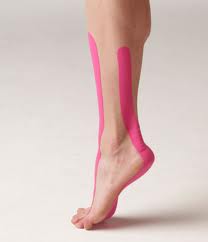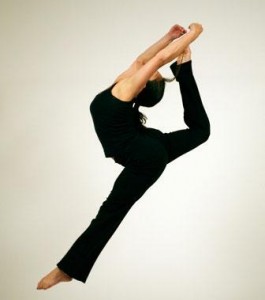Kinesiology Tape for Dancers
Many dance medicine specialists and dancers have begun to use Kinesiotape as a staple to manage their injuries. Developed  more than 25 years ago in Japan by chiropractor Dr. Kenzo Kase, the Kinesiotape method drew worldwide interest when the U.S. Olympic volleyball player Kerri Walsh wore the tape to support her shoulder during the 2008 Games in Beijing. Now many elite athletes, including dancers use Kinesiotape. Unlike traditional athletic tape, the latex-free Kinesio stretches easily, and permits greater range of motion, making it popular with dancers. It allows the dancer to perform while still protecting them from further injury. “The old way of taping was stiff and tried to support ligaments, but we have learned it gave less support than we suspected,” says Dr. Rebecca Clearman, M.D, “Kinesiotape, on the other hand, helps dancers self-correct. (For instance) if a dancer is hyper-extending, it can serve as a reminder at the end of the range to not go as far.”
more than 25 years ago in Japan by chiropractor Dr. Kenzo Kase, the Kinesiotape method drew worldwide interest when the U.S. Olympic volleyball player Kerri Walsh wore the tape to support her shoulder during the 2008 Games in Beijing. Now many elite athletes, including dancers use Kinesiotape. Unlike traditional athletic tape, the latex-free Kinesio stretches easily, and permits greater range of motion, making it popular with dancers. It allows the dancer to perform while still protecting them from further injury. “The old way of taping was stiff and tried to support ligaments, but we have learned it gave less support than we suspected,” says Dr. Rebecca Clearman, M.D, “Kinesiotape, on the other hand, helps dancers self-correct. (For instance) if a dancer is hyper-extending, it can serve as a reminder at the end of the range to not go as far.”
Kinesiotape can be used to stimulate or relax a muscle, depending on the direction of the recoil of the stretched tap. Whether relaxing or activating, the tape gets placed along the line of the muscle. For activating, the direction of the tape goes from muscle origin to insertion. The tape’s degree of stretch determines the strength of the recoil action, so each application can be tailored to a dancer’s needs.
It’s like a brace, but better, because of it allows greater range of motion and also provides proprioceptive input (joint balance). Kinesiotape comes in a variety of brands and can be purchased by the consumer, however initially the tape should be applied by a dance medicine professional with knowledge of dance mechanics. After several sessions the injured dancer can learn to put the tape on properly by himself/herself.
Kinesiotape is not a magic bullet. Proper diagnosis of the injury by a qualified healthcare professional is always the first step and during recovery, proper rehabilitation and correction of biomechanical errors are keys.
-Dr. Rose is a San Diego Chiropractor and a Certified Chiropractic Sports Practitioner®. He is a member of the International Association of Dance Medicine and Sciences and has experience with ballet dancers from youth to professional.



 physical demands placed on the bodies of dancers have been shown to make them just as susceptible to injury as football players. For this reason, more emphasis should be placed on creating awareness of risk and preventing injuries in dancers. Most dancers begin dancing at a young age, the repetitive practice of movements that require extreme flexibility, strength, and endurance make them prime candidates for overuse injuries. In fact, there is little doubt that the vast majority of injuries are the result of overuse rather than trauma. These injuries tend to occur at the foot, ankle, lower leg, low back, and hip. These injuries show up with greater frequency in dancers as they age, so it is extremely important to emphasize what the young dancer can do to prevent future injuries.
physical demands placed on the bodies of dancers have been shown to make them just as susceptible to injury as football players. For this reason, more emphasis should be placed on creating awareness of risk and preventing injuries in dancers. Most dancers begin dancing at a young age, the repetitive practice of movements that require extreme flexibility, strength, and endurance make them prime candidates for overuse injuries. In fact, there is little doubt that the vast majority of injuries are the result of overuse rather than trauma. These injuries tend to occur at the foot, ankle, lower leg, low back, and hip. These injuries show up with greater frequency in dancers as they age, so it is extremely important to emphasize what the young dancer can do to prevent future injuries.

